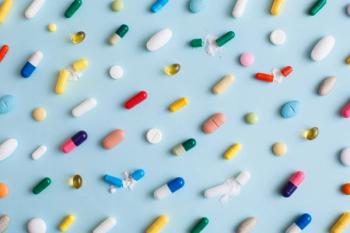
Antidepressant Detriment and Benefit Assessed at NCDEU
New Clinical Drug Evaluation Unit presented new clinical data at their 45th annual meeting in Boca Raton, Fla. In the first of two articles, suicide studies, the effectiveness of antidepressants and the efficacy of drug combination therapy are explored.
Psychiatric Times
October 2005
Vol. XXII
Issue 11
(This is the first article in a two-part coverage of the 45th Annual New Clinical Drug Evaluation Unit Meeting held June 6-9 in Boca Raton, Fla. Part II will review innovative research methodologies presented at the conference--Ed.)
The prospect of suicidality emerging from antidepressant treatment was of central concern in the lead-off workshop, and inadequate antidepressant response was the topic of another panel and several new studies reported at the 45th Annual National Institute of Mental Health-sponsored New Clinical Drug Evaluation Unit (NCDEU) Meeting held in June in Boca Raton, Fla.
Monitoring Suicidality
In the workshop "Clinical Evaluation of Safety in Psychopharmacology" Benedetto Vitiello, M.D., chief of the Child and Adolescent Treatment and Preventive Intervention Research Branch at NIMH, characterized the safety of pharmacological interventions as a "major public health concern." Despite this, he acknowledged, "identifying a causal link between treatment exposure and harm can be a challenging and sometimes inconclusive effort."
Mark Olfson, M.D., M.P.H., director of Mental Health Research Core, associate professor of clinical psychiatry at Columbia University and a pharmacoepidemiologist who assisted in the U.S. Food and Drug Administration evaluation of antidepressant clinical studies in children for suicidal ideation and behavior, observed in the workshop that the studies were well designed to evaluate short-term efficacy of antidepressants, but "were poorly designed to test the overall effects of antidepressants on risk of suicide."
Olfson emphasized the need for future trials to distinguish between and monitor for suicidal ideation, attempts and suicide. He urged researchers to carefully consider the strengths and limitations of various methodologies to accomplish this.
Charles M. Beasley Jr., M.D., and colleagues at Eli Lilly and Company reported in a poster session on their efforts to formulate a nomenclature for suicidal behavior that could facilitate monitoring, intervening and reporting in clinical trials. Beasley proposed that events be described as: 1) completed suicide; 2) nonfatal suicide attempt; 3) aborted suicidal act; 4) preparatory suicidal act; 5) suicidal ideation; 6) instrumental suicidal act (suicidal gesture); and 7) non-suicidal, deliberate self-harm.
Beasley suggested, further, that case descriptions include characterization of intent to die; intent to influence others; degree of self-harm; self-perceived lethality; planning of attempt; action taken to prevent intervention, interruption; the act or expression of ideation; and social stressors.
An attempt to predict suicidality during treatment with a selective serotonin reuptake inhibitor based on pretreatment frontal electroencephalogram activity was reported by Dan V. Iosifescu, M.D., of Massachusetts General Hospital at a poster session. Iosifescu and colleagues recorded four-channel EEGs before treatment and then prospectively evaluated a three-parameter EEG model, which had been developed to predict response to treatment.
In the first four weeks, six of 42 participants experienced new or worsened suicidal ideation and 19 experienced improvement. Iosifescu reported that their EEG model significantly correlated with change in suicidal ideation from baseline, "even when adjusting for changes in the severity of depression [as measured by change in Hamilton Rating Scale for Depression (HAM-D) score] and for the specific SSRI utilized."
Iosifescu concluded that with use of automated analysis of frontal EEG, "it may be possible to predict prior to treatment which [major depressive disorder] subjects will experience worsening suicidal ideation during SSRI treatment."
Loss of Antidepressant Effect
Although the emergence of suicidality does not necessarily correspond with loss of antidepressant effect, several research reports on relapse and worsening of depression symptoms were considered possibly to inform reduction of that risk. In a poster session, Cristina Cusin, M.D., research fellow in psychiatry at Harvard Medical School and Massachusetts General Hospital, described an Eli Lilly-funded study on early symptomatic worsening during treatment with fluoxetine (Prozac). Although fluoxetine was the only antidepressant that had demonstrated efficacy in childhood depression in the studies reviewed by the FDA, it has also been associated with risk for suicidal ideation.
Cusin said it is not known whether worsening of depressed mood after beginning antidepressant treatment occurs in the natural course of a patient's illness or in response to treatment. Cusin et al. examined the acute pattern of response in 839 patients with depression treated with 20 mg/day fluoxetine for 12 weeks. Patients without symptom worsening were compared to patients with early worsening, corresponding to at least a five-point increase in HAM-D score. In this multi-study population, approximately 25% had experienced early worsening with no correlation to gender, age, HAM-D score at baseline, number of previous episodes or the duration of illness.
Patients with increased HAM-D scores at weeks 2, 3, 4 or 6 had statistically significantly lower probability for improvement by either weeks 8 or 12. Cusin concluded, "Early clinical worsening is common and associated with decreased likelihood of achieving remission."
In another poster session, Patrick McGrath, M.D., from the New York State Psychiatric Institute reported on a NIMH-sponsored prospective study conducted with colleagues at the Psychiatric Institute and Massachusetts General Hospital to ascertain predictors of relapse during fluoxetine treatment. Responders to 12 weeks of treatment were randomized under double-blind conditions either to continue fluoxetine or receive placebo for 52 weeks.
McGrath noted that, contrary to expectation and to previous retrospective analyses, the pattern of acute response was not predictive of relapse. "Chronicity, neurovegetative pattern, severity, and female gender were all associated with a significantly increased risk of relapse," McGrath reported.
The investigators concluded that much of the apparent loss of response to an antidepressant is related to characteristics of the illness and were unable to predict relapse on drug compared to placebo.
In a panel discussion of the effect of psychotropic drugs on suicidality, Ross J. Baldessarini, M.D., of McLean Hospital, pointed out that only lithium (Eskalith, Lithobid) has "substantial and consistent" evidence of reducing rates of suicide and attempts. He cautioned that abruptly stopping lithium increases suicidal risk and noted that even partial nonadherence to a lithium maintenance regimen is associated with increased risk of suicide.
In that panel, Herbert Y. Meltzer, M.D., professor and director of the division of psychopharmacology in the department of psychiatry at Vanderbilt University School of Medicine, reviewed the International Suicide Prevention Trial (InterSePT) comparing clozapine (Clozaril) and olanzapine (Zyprexa) in 980 patients with schizophrenia or schizoaffective disorder at high risk for suicide. The superior results with clozapine led to an FDA-approved indication of clozapine for the reduction of suicide risk in these conditions. Meltzer noted, "Whether clozapine is effective in bipolar suicidal patients, and equal to or synergistic with lithium, requires further study."
Antidepressant Effectiveness
Venlafaxine (Effexor), a serotonin norepinephrine reuptake inhibitor (SNRI), has been compared to SSRIs in several trials and meta-analyses, and was compared to the newer SNRI duloxetine (Cymbalta) at the meeting. The study, conducted by the manufacturer of duloxetine, applied simultaneous evaluation of both efficacy and adverse events through a global benefit-risk (GBR) assessment.
"The GBR approach has the potential to provide information useful for decision-making regarding the appropriate choice of therapy," said lead author David Perahia, M.D., of Eli Lilly at the poster session.
The GBR parameter for effectiveness was remission at end point, with a HAM-D-17 score of ≤7. Risk was defined by four categories of adverse events, from no occurrence to a severe reaction. A positive GBR score indicates that benefit outweighs risk, and higher positive values indicate greater benefit relative to risk. In this GBR analysis with pooled data, there was no significant difference between venlafaxine and duloxetine.
A meta-analysis of all comparative studies with venlafaxine and SSRIs reported at the meeting by Michael E. Thase, M.D., professor of psychiatry at the University of Pittsburgh Medical Center, differed from previous meta-analyses, which had included only the comparative studies funded by the manufacturer of venlafaxine. Consistent with the previous analyses, however, venlafaxine was found superior to fluoxetine, but not significantly different from other SSRIs because of too few studies with each to conclude non-inferiority.
An additional meta-analysis, which compared venlafaxine to SSRIs for anxious depression, was described by Richard Entsuah, Ph.D., of Wyeth Research. From the data of 31 trials, Entsuah reported finding both venlafaxine and SSRIs associated with higher rates of remission at week 8 than placebo and venlafaxine having a statistically significantly higher rate than SSRIs.
Regardless of which antidepressant is chosen, Frederic M. Quitkin, M.D., professor of clinical psychiatry at Columbia University, pointed out in a panel discussion that there is an expected remission rate of approximately 40%. Quitkin and Jonathan W. Stewart, M.D., professor of clinical psychiatry at Columbia University, along with Pierre Blier, M.D., Ph.D., professor of psychiatry at the University of Ottawa, conducted a panel discussion on improving that outcome with strategic application of different antidepressant actions. The panel posed and addressed the session title "Does Mechanism-Based Combination Treatment Improve on Trial and Error Sequential Monotherapy in Treating Adult Depression?"
Quitkin reported on a study in which 171 outpatients with depression were treated with different second-generation antidepressants sequentially through three distinct trials. While intent-to-treat analysis indicated that 113 of these patients (66%) achieved remission, Quitkin reported that 95% of those who completed the three sequential trials achieved remission.
"Our choice to measure outcome following three adequate trials is dictated by good clinical practice," Quitkin said during the panel. Although it is common to assess outcome after a single antidepressant trial, he explained, "cumulative high remission rates suggest antidepressants are effective and should encourage more patients to seek treatment and physicians to develop techniques to improve adherence."
Stewart presented data from an open eight-week pilot study that combined antidepressants with different actions: escitalopram (Lexapro) and bupropion (Wellbutrin). After dose titration, patients received 40 mg/day escitalopram along with 450 mg/day bupropion. Stewart reported that 13 of 38 patients (34%) remitted within two weeks and 23 (61%) by the end of week 8. Nine patients (24%) did not complete the trial, including seven due to adverse events.
In addition to surpassing the researchers' historical 40% remission rate at eight weeks with monotherapy, Stewart told Psychiatric Times that their remission rate at two weeks was substantially higher than the 10% reported in most trials at that time point. "These remission rates are suggestive that some patients may be remitting earlier than with standard monotherapy," he said.
While the favorable end-point rates of remission support his assumption of complementary mechanisms of action, Stewart acknowledged that the putative rapid onset might also reflect the rapid dosing titration. "Further studies assessing efficacy of combination therapy will better determine a possible role for combination therapy as an initial strategy in treating unipolar depression," Stewart concluded.
Preclinical evidence for such strategic combinations was reviewed by Blier during the panel session. He explained that while SSRIs enhance serotonergic neurotransmission (after initial delay until inhibitory 5-HT1A autoreceptors are desensitized), they gradually attenuate norepinephrine neuronal firing through increased inhibitory tone. In contrast, mirtazapine (Remeron) and bupropion enhance norepinephrine release.
"It should be possible," Blier said, "to increase transmission more rapidly and efficiently by combining drugs with different and complementary mechanisms of action."
To the question of whether comparable results might be achieved with one SNRI antidepressant exerting dual actions with fewer potential side effects than concurrent use of two agents, Stewart responded that the difference in potency at the respective noradrenergic and serotonergic sites presents an obstacle to fully exploiting both actions with one agent.
"Duloxetine ... is almost 10 times more potent at the serotonin receptor than at the norepinephrine receptor," Stewart explained to PT. "I translate that to mean that one needs to take 10 times that dose required to obtain adequate serotonin reuptake inhibition in order to get the same degree of norepinephrine reuptake inhibition. The trouble, then, is that I am never sure whether I am giving sufficient SNRI to get adequate NRI effect."
Other research reported at the meeting assessed the addition of an atypical antipsychotic to enhance antidepressant effectiveness. In a poster session, Ian Mackey, M.S., of Rush University Medical Center described aripiprazole (Abilify) augmentation for 10 patients who had not fully responded to antidepressant monotherapy. Although the addition was initially associated with akathisia, this appeared to dissipate by the sixth week of treatment, Mackey indicated, and there was significant improvement of scores for anxiety and depression symptoms.
David L. Dunner, M.D., professor of psychiatry and behavioral sciences and director of the Center for Anxiety and Depression at the University of Washington, reported a similar open eight-week trial with adjunctive ziprasidone (Geodon), which also evidenced greater improvement in efficacy measures than antidepressant monotherapy.
In his panel presentation, Stewart indicated his hope that mechanism-based strategies could ultimately supplant trial-and-error sequential monotherapy, "since some patients continue to suffer through one or more ineffective regimens until an effective treatment is found."
Newsletter
Receive trusted psychiatric news, expert analysis, and clinical insights — subscribe today to support your practice and your patients.













